
Laurent Grasso
“The patterns of displacement through prison, thus, sever social ties at the same time that they connect distinct places. Society’s margin set in stone, prisons render invisible the mix of poverty, crime, and racial inequality that mark actual punishment and put in its place a compelling mythology of law and order.”
Volker Janssen ( Sunbelt Lock-Up: Where theSuburbs Met the Super-Max )
“That which had a political face and imagined itself political will unmask itself one day and reveal itself to be a religious movement.”
Kierkegaard (Fear and Trembling)
“Who is the Dalai Lama? And why does so much of the Italian left tend to accept his “sanctification” and not see his reactionary essence?”
Dominic Losurdo (China, Tibet and the Dalai Lama, 2003)
“Be then his Love accursed; since love or hate,/To me alike, it deals eternal woe./Nay cursed be thou; since against his thy will/Chose freely what it now so justly rues./Me miserable!—which way shall I fly/ Infinite wrath and infinite despair?/Which way I fly is Hell; myself am Hell.”
John Milton (Paradise Lost, book four)
I think there is a tendency in the educated bourgeoisie in the U.S. to minimize the influence of religion in their culture and society. The urban white bourgeoisie imagine their country as secular and rational. And their own beliefs tend toward a deep reverence for science, even if that near religious reverence is compartmentalized. There is a deep unconscious (I suspect) attraction to cult like religiosity in this white bourgeoisie. The U.S. is built on religion and on a strange tradition of religious invention. Religion is connected to all manner of associations with collective action and with political dissent. And, if one simply watches Hollywood entertainment product the saturation of religious background to nearly everything, every narrative, every character, is hard to miss. If you can find a protagonist in American television who is an atheist or agnostic I would be surprised.
Even the growth of the new commodity atheism of Sam Harris or Richard Dawkins has had little real impact. For the core psychic subjectivity of the vast majority of Americans is Christian. I think even consumerism is bound up with Christian values at its inception (More below).

Lucas Foglia, photography.
Nearly all U.S. television drama, which means largely cop shows or lawyer shows or medical shows, have backstories linked to either military *service* or religion, or usually both. (In fact military *service* is a bit like the new seminary for the new green foot soldiers of green capitalism. From alter boys to GIs.) In TV lead characters have nearly always had military training and nearly all have some religious affiliation, or will somehow show respect for religious institutions. In the same way that all Presidents must attend church, all entertainment must ratify religious belief in its main characters. It is the signifier for probity. Statistically religious identification and religious practice account for quite large discrepancies. Fifty some percent of Americans attend church or synagogue or mosque regularly, while eighty some percent self identify as religious.
The role of the internet intrudes here because it affects both how the population views its own religious beliefs and more, how notions of the sacred are affected.
“It is time to abandon the world of the civilized and its light. It is to late to want to be reasonable and learned, which has led to a life without attractions. Secretly or not, it is necessary to become other, or else cease to be.”
George Bataille (The Sacred Conspiracy, 1938)
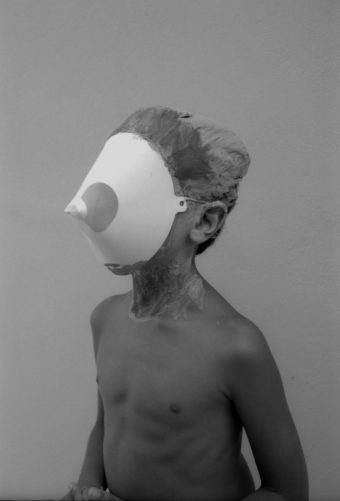
Maria Antelman
“Evangelicals, who have historically been keen to get out their message via whatever communication conduit available, were the first organised religious groups to embrace the web, and non-traditional or sidelined religious movements made early moves online to get their version of “the word” out. In contrast, Islam and Catholicism, which both place an emphasis on shared place in their rituals and view the technology as a mode of logic that could take them in its value direction, have been the most hesitant.”
Aleks Krotoski (Guardian, 2011)
There is a relationship between the role of the sacred and religious institutions. For Bataille, the sacred was a radical *otherness* that is an escape from the instrumental rationality of contemporary investment in security. The sacred has links to death and mortality that are unreasonable. Institutional religion works to trivialize the sacred and domesticate it. And to make it a kind of infantile sacred. (And evangelical Christianity, perhaps paradoxically, is the most infantile in terms of erasing the radical sacred). Much as psychoanalysis was medicalized and made the province of experts, so ecstatic visionary revelations or the search for same, or just for meaning, is made into something only your spiritual guide can help you with –the priest class is like adjustment therapy in this sense. Personal trainers, diet guides and nutritional experts; the priests of DYI individualism.
“In 2009 on the BBC, Jack Straw set up national identity in “decent British values” as that which is against national fascism, carrying out a rejection of otherness in the very act of denouncing it. Every truth-affirming statement is structurally fascist. Foucault defines Bataille’s eroticism as “an experience of sexuality which links, for its own ends, an overcoming of limits to the death of God.” God here is the guarantor of identity and of the truth claim, and eroticism is an ecstasy that has killed God, “in order to lose language in a deafening night”..( ) In the Bataillian experience there is no internal identity from which to confess. As the narrator of Story of the Eye explains, most people are unable to experience the world in this way; “the universe seems decent because decent people have gelded eyes […] I did not care for what is known as ‘pleasures of the flesh’ because they really are insipid; I cared only for what is classified as ‘dirty’” . It is that which is “classified as dirty” with which this experience is concerned, so it is a re-engagement with that which has been abjected, that which has been exiled by the kitsch self.”
Alfie Brown (Losing the Self: Transgression in Lawrence and Bataille)

Gotthard Graubner
“…both Bataille and Baudrillard suggest that capitalism always be shadowed or plagued by fascism because it lacks a heterogeneous sacred or mythic force which fascism purports to provide, or simulates. In a culture deprived of otherness, a desperate ‘artificial construction of the other’ provides, at least fleetingly, a convenient object against which hatred can be directed.”
William Pawlett (Violence, Society and Radical Theory)
Bataille recognized the fungibility of individuals in Capitalism, the productive function and role they play. And it was in his notion of the sacred that something heterogenous loomed as a potential for resisting the inherent trend toward fascism. And hence the system works to neutralize the sacred, to demonize otherness, and then to supplant the heterogenous or radical with an artificial radical, the fascist leader. The false radicalism in the arts is a common phenomenon, but one key aspect was something Adorno noted, too. And that is that the radical nature of art is found in its uselessness. The false radical is in some fashion always useful, always somehow idealizing order (as Bataille put it). Both in the political and in culture the manufacture of fake opposition is now just commonplace.
“For Bataille, fascism emerges, historically, from monarchic sovereignty: both forms are dependent upon mastering, purifying, and/or excluding what are seen as base or lower elements. Further, both fascism and royalty depend upon a social “compromise” since both seek a “connection with homogeneous forms at a certain level”. This is an important point in Bataille’s argument: despite their posturing Fascist and monarchic leaders are not ‘pure’ heterogeneous energies; since they seek to establish and maintain control over the homogeneous sphere of society they must compromise their heterogeneity to achieve this relationship of control and domination. “
William Pawlett (ibid)
Even genuinely radical artists (and in another sense politicans..but more on that below) can be appropriated and domesticated. The radical who suddenly is hosting a celebrity golf tournament for example. And with artists who do refuse, who do reject the appropriation there is always a massive propaganda campaign directed to suggest they actually collaborated. A veritable cottage industry in bringing down the genuine radical.

Rita Rohlfing
There is always a question that arises when discussing religion, or even myth and the nature of the sacred. And this is the origin question. I’m not going to delve into that here, except to say that (as I have said before) that I think theatre, the stage, precedes religion. Religion came out of that ur-art form, theatre. But since Bataille is being discussed a bit here, its interesting that Bataille saw the sacred existing and thereby, for a variety of reasons, effecting a religious framework for this experience. But just exchange sacred for theatre, and I think I would agree. Of course this is wildly reductive. For one thing there needs to be a definition of what is meant by sacred. It feels a bit like a word that came out of religion to identify and catalogue this experience that the Church would like to control if not, really, abolish. And it may also be that the development of the Church, or of organized religion, had very little to do with the sacred, with ecstasy or with those early creative actions (cave paintings, the remnants of musical instruments, etc…from thirty five thousand years ago). Those paintings constituted, in my mind, the first theatre as well as the first painting. Was this about the sacred? I doubt it. Unless you want to broaden the definition conventionally accepted. In that case, everything is sacred if you lived in an unknown, often very hostile and dangerous world where nearly nobody like yourself existed. As John Berger said, they were a society of arrival. A people of arrival. And none of these words are satisfactory.
The sacred is what is heterogenous. It is that experience for which one can find no category, no definition, no language. This is the Dionysian. Now, I have a problem with nearly all discussions of this idea. Partly because it presupposes so many things, starting with notions of identity. Is revelation a sacred phenomenon. The Sufi dancers find ecstasy in collective choreography, but also in individual submission or surrender to something that cannot be choreographed. Religion, as a concept, feels always reactionary. The organizing of sacred experience is fascistic, even. Every time.
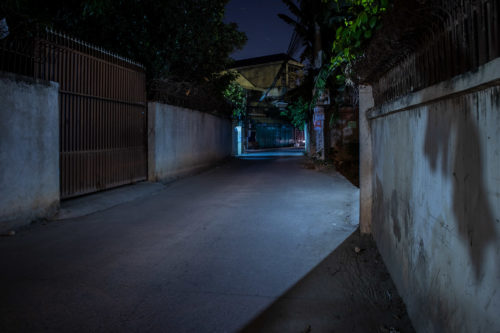
Robert Gotzfried, photography. (Phnom Penh, night).
“The unbearable conditions generated by capitalism also guarantee a place for fascism: the temptation towards facile racist fantasies as a ‘solution’ to the far deeper more complex inequities of the capitalist system, often coupled with the violent desire to cleanse, purify, order and discipline. Bataille is consistent in his argument that “[t]he inability of homogeneous society to find in itself a reason for being and acting is what makes it dependent upon imperative forces”, forces derived from the heterogeneous sphere. So, imperative or operationalised heterogeneity is ‘useful’ to society in that it directs violence externally onto other societies or towards internal enemies: Jews, political activists, the impoverished or unruly. Here heterogeneity and homogeneity join, or slide across each other like tectonic plates, where they merge society deploys “imperative heterogeneity” in contrast to the “vague or undifferentiated heterogeneity” that is characteristic of the experience of the sacred.”
William Pawlett (ibid)
There is a need, and here I think Bataille is right, for fascism to both identify (to use his vocabulary) the heterogenous as a scapegoat, but to also create in either (or all) its leader or its myth, a darker Dionysian side, a hint of destructive force, both sexual and violent. The fascist leader must be a closeted (not too closeted) criminal or fallen god. This is true in a sense of capitalism, too. The secret that is not secret is that violence and punishment are never really disavowed. If fascism has nearly always a religious component, then this is not the sacred (here Bataille is wrong) but the priest class that upholds and creates laws and order.

Giovan Francesco Maineri (Head of John the Baptist, 1502)
Fascism is tied into death and the morbid. In one sense fascism the killing of all otherness, and if that means killing oneself and everything else, well, fine.

George Bataille, identity card 1940.
“Religious apps raise a number of questions about the authenticity of digitized religious practices, due to issues such as the inability to clearly identify a recipient of an app’s prayer or to officially sanction its performance; the unsupervised performance of rituals via apps; the individualized interpretation of sacred texts using app-based tools; industrially rather than institutionally shaped forms of religious social media apps; the out-of-context use of sacred texts and symbols for personal expression via apps; and user-determined use of focusing applications on apps. All of the apps say something about the user who chooses them, as they demonstrate a fluid, streaming religious self, and all place control in the hands of individual users.”
Rachel Wagner (You Are What You Install)

Conrad Marca-Relli
“…the means through which scarcity is instituted also protect us against our own violence. Scarcity is thus a means of protection against violence, and, like the sacred, it is a violent means of protection against violence. Scarcity came about through a transformation of the moral ecology of human relations. More precisely, scarcity was socially instituted by the progressive abandoning of traditional obligations of solidarity, obligations that constrained agents to shoulder duties to help and support specific individuals among those in need. As many anthropologists have noted, in principle, as long as such obligations are binding, no member of the group is in danger of dying of hunger unless all are. Of course, there must be many situations in which this ideal of solidarity has not actually been achieved. However, in such cases scarcity has not been the problem, but the failure of various individuals to fulfill their obligations. It is only when many individuals start to distance themselves from their reciprocal obligations of solidarity in general, when they become sufficiently detached from the duties those obligations entail, that scarcity, want, lack of resources can come to be seen as the problem. The more these obligations are abandoned, the more scarcity is viewed as the “real” cause of the difficulties so many agents face.”
Paul Dumouchel ( The Ambivalence of Scarcity and Other Essays)
This is an interesting sort of definition of the difference between socialism and capitalism. Allow me another quote from Dumouchel…
“Once abandoned by their group of solidarity, individuals simply fall through the net of reciprocal duties and obligations. They are left to fend for themselves alone. It follows that the victims of scarcity are in many cases not the victims of anyone in particular; often no one has threatened or attacked them. They are just in need, but no one will help them; mainly, they are the victims of everyone’s indifference.”

Wolfgang Tillmans, photography.
Solidarity is in need of constant maligning by a system predicated on a manufactured scarcity. And religion is created in a form that mislabels indifference and obligation. And especially makes sure that solidarity is viewed with acute suspicion. This week billionaire presidential candidate Michael Bloomberg ratified a law that made it illegal to feed the poor. Donations, he said, could not be checked accurately for salt content and hence it was irresponsible to hand it out to the needy. Now Dumouchel is right about a great many things here (and very Girardian) but he is wrong to suggest that scarcity is never intentional. Of course its intentional. There is a missing class analysis to much of Dumouchel. That said, he is also right that the designs of the ruling class is not the entire explanation. And here one returns to the role of religion and the sacred. One of the problems, or thee problem, with Girard’s theory of mimesis and violence is that it fails to explain modern war and genocide. This has been pointed out numerous times and its true. But the problem, and Girard even said this (off handedly) is that Christianity has disrupted the scapegoat mechanism. Again I might argue here that class analysis is what is missing. But he is right, too, that given the U.S. is the dominant world power and the cause of nearly all destabilization and collective violence today, that religion (Christianity) plays a significant role in the psyches of individuals involved. The contemporary American has been formed in a society of deceptively acute and insidious religious indoctrination.
Political violence is planned and instrumental today. And the fascist leadership is expressing the disfigured religious principles of the priest class. For the U.S. there are class markers for religious affiliation…as I mentioned above. Cutting across all classes is also the instrumental positivist and cult like belief in all science. But the mimetic explanation is now subsumed by the rationally organized system of domination that is contemporary capitalism. Its not that its not true, it is that this truth becomes nearly invisible.
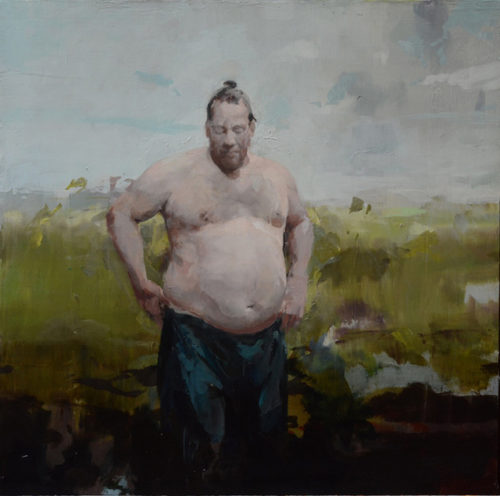
Alex Kanevsky
How the sacred is to be experienced, if it is experienced, or is possible today, is a haunting question.
Pawlett quotes Bataille (from Pawlett’s The Sacred and Society):
“Nothing, as a matter of fact, is more closed to us than this animal life from which we are descended’. The animal state is enigmatic. It is very close (indeed, inside us), yet, at the same time, tremendously remote and exterior: ‘The animal opens up before me a depth that attracts me and is familiar to me. In a sense, I know this depth: it is my own. It is also that which is farthest removed from me, that which deserves the name depth, which means precisely that which is unfathomable to me”.
Bataille (Death and Sensuality)
Bataille believed that the first tool, found in places where there were early cave paintings, was a rupture with the state of wonder in which even earlier humans lived. I say wonder for lack of a better word. We cannot know at all what that was like, and Bataille notes this too, that those animals from which we are descended remain utterly opaque and mysterious. Both distant from us and a part of us.
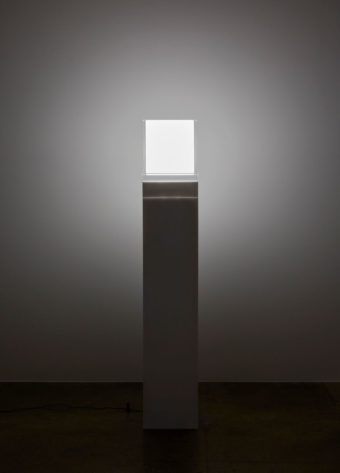
Mary Corse
Bataille notes that, and I think he is right, that the sacred then was tied into death and hunting and animality. It was the moral ecology of the hunt made ritual, made repetition. Burial rites had existed from even before Lascaux and other cave sites with paintings. I think early monotheistic religions developed from the hunt, from the theatre of the caves, as did speech itself. The priest class then came to invent Satan. The fallen angel, the fascist speaker or orator. Milton intuited in a profound manner the essence of Satan.
For the priest class the worst sin is unproductivity. Lack of work cannot be confessed away.
“I discussed the similarity perceived by man in ancient times between the act of love and sacrifice. They felt the immediacy of sacrifice more strongly than we do, for we never perform a sacrifice. The sacrifice of the mass is a reminder but it only rarely makes a deep impression on our sensibility. However obsessive we find the symbol of the Cross, the mass is not readily identified with the bloody sacrifice. ”
George Bataille (Death and Sensuality)
The sacred is sacrificial. And this leads one to re-think Girard yet again. For there is and must be a deep ambivalence to sacrifice.

Thomas Demand, photography and media.
“Crucial to Bataille’s approach is the assumption, or hope, that humanity still feels or experiences servility, avarice and work as painful and humiliating. Without these aversions it is hard to see how society has a future beyond its slow annihilation by capitalism. Contemporary society trumpets what it calls the ‘breaking’ of taboos, but this is not the energising transgression of prohibitions but rather the irreversible elimination of all limits to the operation of capitalist markets, producing the homogeneous space of work/consumerism. “
William Pawlett (The Sacred and Society)
Somewhere Pawlett suggests Globalization is like a house with no door to the outside. There is no outside to globalization. And this becomes a kind of metaphor or parable. I have never been able to listen to anything for very long if I have to listen on headphones. I would much rather listen to Bach or Hank Williams in a room. The headphones place me in some indefinite non place, a space that is inescapable. It cannot be escaped without stopping the music, as it were. And this is like globalization today, neo liberalism, for this is that indefinite space that has no borders, no outside. It is life led inside a pair of headphones. Headphones for the planet. This stretches that parable…but only slightly. And as Bataille perceptively observed, taboos are just impediments to new markets. And so transgression feels less and less transgressive. There is, under capitalism, a built in but silent dealer in dispensations. And this provides a certain aspect of a definition for sacred. The sacred is that which opens a portal to an outside.
“Sacred “places” are openings unto another world or witnesses to its irruption into this one. A space in which there are sacred places, a space that is structured by their presence, is, by definition, discontinuous and heterogeneous. Understood in this way, the course traveled by a nomadic tribe does not determine a territory so much as it describes apilgrimage. It does not, that is, delimit a continuous space over which a group or political entity claims exclusive authority.”
William Pawlett (ibid)

James Casebere (Theatre after the Acropolis)
In class society the dealer of dispensations, then, is the ruling class — for there is no clear border for moral or ethical law. No dispensation is needed, actually, because the morality of capital is borderless. In criminal justice the oppressed class must show remorse. The ruling class doesn’t. But they don’t really participate in the system at that level. Still, there is a connection between the American religious tradition and the rise of fascism today, and screen habituation and the loss of thinking. Literally people seem less and less able to think. And even over the last, say, five years one can notice clear corrosion of basic reasoning. And then the climate crisis. And I am increasingly coming to think the climate crisis is barely about the climate. It is about a religious awakening, a sort of deeply puritanical pull toward something that stands in for the sacred. That’s one aspect, the other primary part of this is of course what is now being called Green Capitalism. The re-entrenchment of capital to save itself. But it is a stalling action, while what is left of the planet is bought up by the 1%. There is a deep delusion in ruling class thought, too. The desire to de-populate and control reproduction begs questions that the global multi billionaires cannot answer. Bill Gates or Jeff Bezos or any of a dozen others are not deep thinkers. They are caught in their own sacrificial mechanism, too.
But the foot soldiers for the Green Church are white educated Bourgeoisie — and I think perhaps mostly men. The climate church is a white church. It keeps losing traction psychologically because the narrative plastered over the whole thing (the sort of Al Gore narrative via Greta and Gates and Attenborough et al) is barely coherent. And the goal posts have to be moved every six months it seems. And since there is a deep problem, a severe truly monumental problem of pollution, of toxic poisoned air and land and water– the battle to reclaim an anti capitalist narrative is very difficult. But that is another story. For the moment, for this post, I am interested in how the loss of sacred experience (again, that word must be dealt with more) — the loss of experience itself has contributed to shaping the new religiosity and fascist eugenicist groundswell. There is no way to overstate the effects of the internet and screen communication in all this. There is a presidential diplomacy now conducted by twitter. Its not, really, of course, but that is the manufactured perception.

Emmit Gowan, photography (Nevada test site)
“The next morning dawned clear and crisp: a suitable blessing for Sunday, August 24, 1873—the Lord’s Day, of course. Jackson rose with the sun to seize his opportunity. He once more arranged his camera equipment and prepared the mountainside darkroom he would need to develop the images properly. Somehow, he managed to expose all eight plates he had wrapped protectively for his climb, and with the largest pane of glass generated what his 1988 biographer P. B. Hales anointed “the most famous image ever made of an American mountain.” The photo of the Mountain of the Holy Cross, formally presented to Congress and to President Ulysses S. Grant, received wide distribution and caused a national sensation. It became the subject of thousands of reproductions, postcards, souvenirs, and even a U.S. postage stamp in 1951”.
Michael Medved (God’s Hand on America)
The story of Holy Cross Mountain is an American parable. First, its rather an underwhelming image even if you try to imagine it in the 1870s. Second, the right arm of the snowy cross fell off sometime during WW2. Eventually people stopped visiting, though even peak tourism never amounted to more than a couple thousand a year. But tourism came to replace much of the time Americans previously spent in church. And while it is fatuous to call Star Trek conventions religious, its also not completely without truth. Also, as Michelle Lelwika notes in an essay on the diets and the female body, and on the structural relationship to salvation stories, Americans imbue every social endeavour with a quality of Christian belief. And often this means a fantasy past of old fashioned Quaker meeting halls or Puritan and always with a curiously white slant. Colonial protestantism is still the template for storytelling in America.

Historic first photo of Holy Cross Mountain, Colorado, taken by W.O. Jackson 1873.
But I want to note, again, how the climate discourse is disfiguring everything including academia and anthropology. Here is a quote from Lynn Parramore’s review (sort of) of Jeremy Lent’s book The Patterning Instinct.
“Lent presents evidence that early hunter-gatherers emphasized connectivity rather than separation, a mindset that engendered a more egalitarian social structure. (Unfortunately, they also lived by a metaphor of nature as an endlessly giving parent, resulting in problems like overhunting, which illustrates that even seemingly harmless metaphors can eventually lead to catastrophe).”
Lynn Parramore (Institute for New Economic Thinking)
Beyond being risible this sort of kitsch new agey junior high school level theory (sic) speaks to the trend toward societal lost thought.
Right…Lascaux man imagined the world as an all giving parent.

Ad Reinhardt
But people have begun to imagine history through the lens of stuff like 12 Step Programs, or diet projects, or science fiction or comic book conventions. There is something lurking in the collector and hobbiest figures that is worth considering. As Adorno noted, hobbies are just a continuation of ‘profit oriented social life’. The evolution of hobbies and leisure time became connected at some point with boredom. There is also a question of productivity, again. Americans more than anyone else use leisure (and collectors or hobbyists do this) to reproduce work. It is reproducing alienated labor. The amateur cartoonist knows his cartoon ‘work’ is bad — but he carries on because he knows only the repetitive reflex of labor and neurosis. Dave Harris noted, in an essay on Adorno, the amateur hates his own failed work. But he justifies to himself the “pleasure” he or she gets from the familiarity of the activity. And Americans in general, I think, are the most self loathing society on earth. I find Scandinavians passive aggressive, for example, as a society. But Americans are angrier. And that anger is turned inward, only later to be projected out into the world. On the most vulnerable, usually.
But the religious residue in hobbies and public shaming, symbolic lynchings, and the lynch mob mentality that always finds its level with the adoration of Judge Holden character types. American literature’s greatest creations are authoritarian and effective, if not ultimately self destructive. Ahab to Holden, these are particularly American creations. The difference today is that there is no public to differentiate an Ahab from Joe Arpaio.
“The first colonists saw in America an opportunity to regenerate their fortunes, their spirits, and the power of their church and nation; but the means to that regeneration ultimately became the means of violence, and the myth of regeneration through violence became the structuring metaphor of the American experience.”
Richard Slotkin (Regeneration Through Violence)
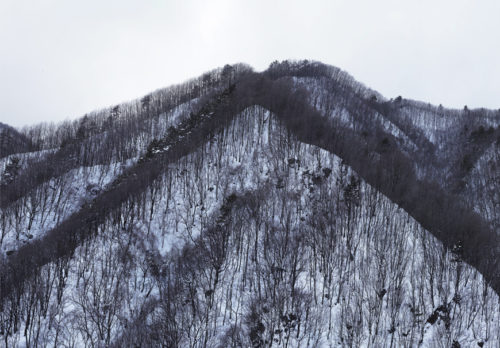
Boomoon, photography.
The hobbyist is engaged in something anal sadistic at its origin. There is really no improvement granted in hobbies.
But hobbies are withering away, I suspect because of the smart phones and screen habituation. There is an ap for that. But it may also be that while the sadistic component is lessened, generalized, with screen time replacements, that very generalized dilution probably has the deeper downside of reducing experience and strong emotions, even if destructive.
The banality of the hobbyist or the ersatz religion of comic book enthusiasts is the arena of the lost sacred. It is a denial of death, and at its core all collectors are fascist. It is the fetishizing of ownership. Its meaningless ownership often, but it is imbued with a dishonest enthusiasm. Leisure must imitate labor where there is mostly only a memory of labor.
The trivialization of art speaks to this same loss. Scorsese’s new film The Irishman is nearly an animated film given the amount of CGI involved in changing the age of various actors for various scenes. Based on a book written by an obvious fraud, this bit of historical revisionism is a bit like a pastiche or sampler of all previous Scorsese films.
The sacred challenges prohibitions, too. That is part of its role (this again touches on Girard). The American character has seen a waning of serious emotions and thoughts. But while the sacred has eroded, the sadism and cruelty that formed a dialectic has not. The violence in fact has now come to absorb much of the surplus emotion that deteriorated rituals and belief and master narratives have provided. It is a society of pettiness and mean spirited pseudo clergy. That is its visible nature because the people who manage the images are that pseudo clergy. White desperation and a deep desire for a return to what never was is driving the culture. And that, in the end, is fascist.
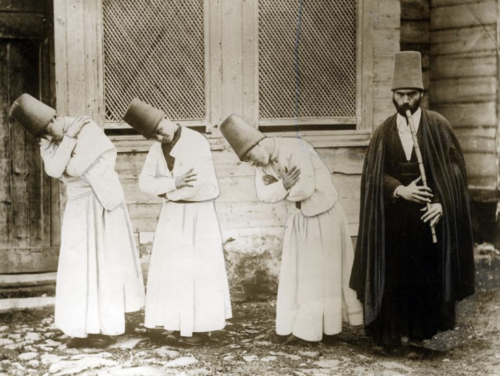
Mevlevi Sufi dervishes, late Ottoman era.
To donate to this blog use the paypal button at the top of the page. I hasten to point out that I have continued to to avoid all advertising — because I want a page where the ugliness of consumerism and manipulation is absent. If that is appreciated this holiday season, please do donate something.

i post this for regino….
Dear Dr. John Stepling,
Thank-you for your brilliant, illuminating
Winter Holidays’ essay of today. Having cited
Kierkegard, there was no need to repeat the link
to the strange and uncanny that is encrusted in
the sacred. As a long ago ex-communicated adjunct
professor of mathematics ( and, before that, electrical
engineer), I could easily relate, as the they say, to
your incepts regarding the almost Taylorist instrumentality
that was revealed by the likes of Marcuse and Sweeny. In
fact I remeber attending community colleges in the
late 60’s and having to take a course titled “Psychology of
Adjustment” that made me feel, among other horrible affects, a
sense of being a pin ball or a robot in a clean- except for
the blood of the experimental objects, behaviorist lab.
But, I believe, the authentic experience of the sacred,
must have dread as itds kernel. Kafka and, in spite and because, of
its aspect of childhood and wonder, Hermann Hesse, too. Against
that awareness, the priestly class has labored genocidally for
millenia.
This is, as you indicate or suggest, resolutely opposed to the what
I, I- at least- find as repulsive necrophylia such as a recent article
in CounterPunch calculating that human life is a sexually transmitted
disease whose cure is climate change in the anthropocene.
As for some among us, there were icy white Pennsylvania winters
in the primal, medieval catholic schools, and of many and diverse
theologies to remember along old, perhaps much diverse understandings
of existence.
My wife and I wish you the best for the holidays and beyond.
Dr. Regino R. Diaz-Robainas
Stuart, Florida
Unusual Silence
Dear John,
I want to express my gratitude for
presenting my comment. Let’s hope, with
suitable Gramscian pessimism of the intellect, that
I did not jynx the desperate need for cheer in a
physically and ontologically mostly homeless system.The repression and channeling into
hobbies of various beyond krieg ‘ shades
of postmodern fascism.
Among these shades, the wonderful world of
deeply fake cannonical Science and its twin sibling,
Technology mayand/or could be their stronger anchors. This
phenomena are so, not just their surface seedlings of
obvious manipulation by the corporate state, but in the
unconscious manipulation of the taxomonies of our thinking
and moods. Once again, origins: I remember taking a
summer course during 1980 to complete my BS undergraduate
requirements, in what was then a relatively recent technology,
Microprocessors ,before the so-called dawn of the Chaplinesquely
market IBM pc.
What struck me- I was younger and less familiar with
the kafkaesque embryonic zeitgeist starting to slouch towards
the neoliberal dread circus we’ve come to know. It was the way
the sacred chip was patterned to match an ideal corporate
hierarchy, from the Executive brain to the ports ( with migrant data
incoming and outgoing ) with guards permitted interupts rarely allowed
to suspend the main program.
We don’t want to become zombie ubermenschen, or Captain Kirk. We just want
to take the free-from-fascism buds of Nietszche’s advise and
bring some chaos into our lives to give birth to a dancing
star.
Happy true holidays to you and your wise readers.
Made me think of David Noble’s “Religion of Technology”